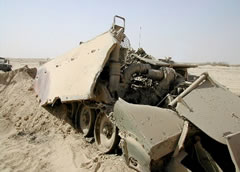“Vehicle Armoring – MRAP and Beyond“ < Page 4 of 8 >
While the first MRAPs are arriving in the combat zone, threats are already deteriorating almost daily, necessitating further armor improvements on all vehicles. Many new potential threats are lurking in a combat zone. The most common and most lethal so far were ‘kinetic’ weapons – i.e. fast projectiles, fragments or debris causing lethal effect by impact on the target. Their lethality is determined by the amount of kinetic energy transferred to the human body and the level of damage they cause (concussions, tissues damage, ruptured blood vessels etc.)
 Other threats are caused by a combination of kinetic energy and explosion-generated heat – these are the shaped charges, which are highly lethal against ballistic armor. Small arms fire from hand guns, rifles, machine guns or heavier automatic cannons are the most common kinetic weapons, but fragments and or metal shrapnel dispersed by mortar bombs small rockets, Improvised Explosive Devices (IED), dispersing nails, screws or metal balls at high velocity, over a large area are also effective and highly lethal kinetic weapons. Heavy explosion blasts also have a devastating effect on targets, particularly the human body. More specific weapons designed to affect human targets include Chemical, Biological or Radiological weapons (CBR). More recently, directed energy weapons (including laser dazzlers, and temporary or permanent ‘blinding’ by laser or application of high-power microwave beams – all offer new ways to quietly and effectively incapacitate humans at relatively long distance.
Other threats are caused by a combination of kinetic energy and explosion-generated heat – these are the shaped charges, which are highly lethal against ballistic armor. Small arms fire from hand guns, rifles, machine guns or heavier automatic cannons are the most common kinetic weapons, but fragments and or metal shrapnel dispersed by mortar bombs small rockets, Improvised Explosive Devices (IED), dispersing nails, screws or metal balls at high velocity, over a large area are also effective and highly lethal kinetic weapons. Heavy explosion blasts also have a devastating effect on targets, particularly the human body. More specific weapons designed to affect human targets include Chemical, Biological or Radiological weapons (CBR). More recently, directed energy weapons (including laser dazzlers, and temporary or permanent ‘blinding’ by laser or application of high-power microwave beams – all offer new ways to quietly and effectively incapacitate humans at relatively long distance.
Other threats are caused by a combination of kinetic energy and explosion-generated heat – these are the shaped charges, which are highly lethal against ballistic armor. Small arms fire from hand guns, rifles, machine guns or heavier automatic cannons are the most common kinetic weapons, but fragments and or metal shrapnel dispersed by mortar bombs small rockets, IEDs, dispersing nails, screws or metal balls at high velocity, over a large area are also effective and highly lethal kinetic weapons. Heavy explosion blasts also have a devastating effect on targets, particularly the human body. More specific weapons designed to affect human targets include Chemical, Biological or Radiological weapons (CBR). More recently, directed energy weapons (including laser dazzlers, and temporary or permanent ‘blinding’ by laser or application of high-power microwave beams – all offer new ways to quietly and effectively incapacitate humans at relatively long distance.
Explosive devices pose various levels of threats. Originally, when used as an individual device, IEDs caused limited damage and could be avoided by careful adherence to operational procedures. Yet, these procedures are also acting against the military force, as in many cases, IED are triggered used to “shape the battle”, causing the military unit to respond in a predicted procedure, where more sophisticated devices are employed, aimed specifically at certain weak points identified by the insurgents.
Firearms are the #2 cause of casualties among US troops in Iraq and Afghanistan. Small-arms are employed in firefights erupting in urban, open terrain combat, or by ambush teams covering an IED event, as well as by snipers. Most vulnerable are foot patrols, troops dismounting from their vehicles (for example, at an area where an IED went off) and exposed warfighters in armored vehicles. Armor piercing rounds are now common almost everywhere, augmenting standard ‘Full Metal Jacket’ (FMJ) rounds which could be stopped with the most common types of body armor and vehicle protection. Properly used body armor and helmet can usually reduce the risk from most kinetic threats, but cannot guarantee full protection.
Effective vehicular protection against basic small arms threats is provided by hard steel plates, composites or ceramic armor. As mentioned above, 7.62mm AP poses a major threat requiring heavier armor, which can be attained by beefing-up the protective layers, either by additional elements placed outside the vehicle (supply boxes, spare wheels, spare tracks etc) or beefing-up the vehicle’s armor with appliqué ceramic tiles, composites or hard steel plates. The larger, more capable small-and medium- caliber rounds are associated mainly with higher intensity conflict, include heavier weapons such as 12.7, 14.5, 23 and 30mm rounds.
Additional parts of “Vehicle Armoring – MRAP and Beyond” article:





















